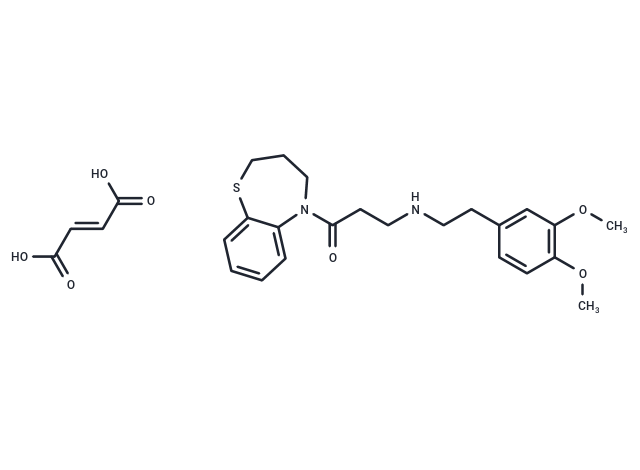Shopping Cart
- Remove All
 Your shopping cart is currently empty
Your shopping cart is currently empty

KT-362 fumarate is a novel compound that acts as an antagonist of calcium channels, potassium channels and sodium channels.KT-362 fumarate causes vasodilation by affecting intracellular calcium mobilization in atrial muscle cells.KT-362 fumarate has a relaxing effect on femoral and basilar artery strips in rabbits.

| Pack Size | Price | Availability | Quantity |
|---|---|---|---|
| 1 mg | $323 | In Stock | |
| 5 mg | $747 | In Stock | |
| 10 mg | $1,050 | In Stock | |
| 25 mg | $1,560 | In Stock | |
| 50 mg | $2,080 | In Stock | |
| 100 mg | $2,830 | In Stock |
| Description | KT-362 fumarate is a novel compound that acts as an antagonist of calcium channels, potassium channels and sodium channels.KT-362 fumarate causes vasodilation by affecting intracellular calcium mobilization in atrial muscle cells.KT-362 fumarate has a relaxing effect on femoral and basilar artery strips in rabbits. |
| In vitro | We studied the effects of KT-362, (5-[3[2-(3,4-dimethoxyphenyl)ethyl]amino]-1-oxopropyl]-2,3,4,5- tetrahydro-1,5-benzothiazepine fumarate), a newly synthesized vasodilating and antiarrhythmic agent, on membrane currents of single guinea pig ventricular cells, using whole-cell voltage-clamp techniques. In the steady state with a stimulation frequency of 0.5 Hz, KT-362 at concentrations of 10 and 30 microM decreased the peak sodium current (INa) in a concentration-dependent manner, i.e., by 27% and 49%, respectively. KT-362 (30 microM) inhibited INa by 21% at 0.2 Hz and by 51% at 1 Hz. In addition, KT-362 (10-30 microM) decreased the L-type Ca current (ICa) in a concentration-dependent fashion. KT-362 (10-300 microM) decreased the maximum rate of rise of action potentials provoked at normal (2.7 mM) K+ concentration and that provoked at high (20 mM) K+ concentration. KT-362 at concentrations over 100 microM significantly depolarized the resting membrane, and the action potential duration remained unaltered. From these findings, we conclude that apart from the alleged inhibitory effects of this agent on the release of calcium from sarcoplasmic reticulum (it is therefore termed 'an intracellular Ca++ blocker'), KT-362 suppresses a variety of membrane ionic currents of cardiac cells.(ABSTRACT TRUNCATED AT 250 WORDS).[1] |
| In vivo | The effects of a new intracellular calcium antagonist, KT-362 (5-[3-[[2-(3,4-dimethoxyphenyl)-ethyl]amino]-1-oxopropyl]- 2,3,4,5,-tetrahydro-1,5-benzothiazepine fumarate) on myocardial infarct size following a 90-min occlusion and 3-h reperfusion of the left anterior descending coronary artery (LAD) were determined in anesthetized dogs. KT-362 (300 micrograms/kg/min for 20 min followed by 150 micrograms/kg/min for 80 min) was administered intravenously (i.v.) 10 min prior to coronary occlusion and continued throughout the occlusion period in separate experimental groups. KT-362 produced a reduction in heart rate (HR) and the HR-systolic pressure product. Mean arterial pressure (MAP) was reduced during occlusion and early reperfusion in the KT-362-treated group, and segment function (% segment shortening) was improved during the first hour of reperfusion. As compared with the control group, KT-362 produced a marked reduction in myocardial infarct size.[3] |
| Alias | KT-362 fumarate, KT362 fumarate, KT 362 fumarate |
| Molecular Weight | 516.61 |
| Formula | C26H32N2O7S |
| Cas No. | 105394-80-7 |
| Smiles | C(=C/C(O)=O)\C(O)=O.C(CCNCCC1=CC(OC)=C(OC)C=C1)(=O)N2C=3C(=CC=CC3)SCCC2 |
| Relative Density. | no data available |
| Storage | Powder: -20°C for 3 years | In solvent: -80°C for 1 year | Shipping with blue ice. | |||||||||||||||
| Solubility Information | DMSO: 5.16 mg/mL (9.99 mM), Sonication is recommended. | |||||||||||||||
Solution Preparation Table | ||||||||||||||||
DMSO
| ||||||||||||||||

Copyright © 2015-2025 TargetMol Chemicals Inc. All Rights Reserved.